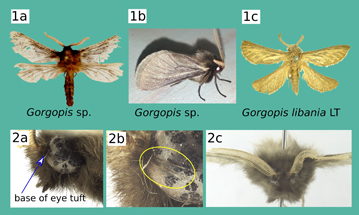Abstract
A partially damaged male imago reared from a larva feeding on Eragrostis curvula (Poaceae) was identified as a species of Gorgopis. Adult and immature stages of the reared specimen are illustrated. The larva lives within a tunnel in the soil. At the ground surface, the tunnel extends above ground as a tube of grass stalk fragments cut by the larva and bound together by silk. These feeding tubes are found at the base of grass tussocks, principally among the dense accumulation of dead stalks. It is not known if the larvae feed on dead or live grass foliage, or a combination. The feeding tube is the second mode of larval feeding documented for ground dwelling southern African Hepialidae, the other being 'silk purser' feeding webs of unknown taxonomic status. The lectotype for Gorgopis libania Cramer, 1781 is here designated.
References
- Aurivillius C. 1910. Lepidoptera, pp. 1–56. In: Wissenschaftliche Ergebnisse derSchwedischen Zoologischen Expedition nach dem Kilimandjaro, dem Meru und den Umgebenen Massaisteppen Deutsch-Ostafrikas. Vol. 2 (Y. Sjöstedt, editor). Uppsala, Almoqvist and Wiksells, 784 pp.
- Cramer P. 1780. De uitlandsche kapellen voorkomende in de drie waereld-deelen Asia, Africa en America, by een verzameld en beschreeven door den heer Pieter Cramer (etc.). S. J. Baalde, Amsterdam. 61 pp. https://doi.org/10.5962/bhl.title.65748
- Cruden F. 1917. Note on the occurrence of trap door caterpillars at Alicedale. South African Journal of Science 13: 196.
- Dugdale J. S. 1994. Hepialidae (Insecta: Lepidoptera). Fauna of New Zealand 30: 1–64.
- Grehan J. R. 1989. Larval feeding habits of the Hepialidae (Lepidoptera). Journal of Natural History 23: 803–824. https://doi.org/10.1080/00222938900770421
- Grehan J. R., Mielke C. G. C., Ignatyev N. & Groof. B. de 2021. New species of Eudalaca Viette, 1950 ghost moth from Karkloof Nature Reserve, South Africa (Lepidoptera: Hepialidae. ZooNova 11: 1–9.
- Grehan J. R., Ochse G. & Ritky S. 2018. New host and distribution records for Leto venus (Cramer, 1780) (Exoporia: Hepialidae) in South Africa. News of the Lepidopterists' Society 60: 147–149.
- Grehan J. R. & Ralston C. D. 2018. Observations on larval tunneling by the enigmatic South African Keurboom Moth Leto venus (Cramer, 1780) (Lepidoptera: Hepialidae). Metamorphosis 29: 82–88.
- Grehan J. R. & Rebelo A. 2021. Mystery of the silk purser moths (Lepidoptera: Hepialidae). News of the Lepidopterists' Society 63: 78–80.
- Hampson G. F. 1910a. Descriptions of new African moths. Annals and Magazine of Natural History 6: 145–160. https://doi.org/10.1080/00222931008692834
- Herrich-Schäffer G. A. W. 1850–[1869]. Sammlung neuer oder wenig bekannter ausser europäischer Schmetterlinge, (1) 1. pls. [moths]: [1–16] ([1853]), [17–48] ([1854]), [49–68] ([1855]), [69–70] ([1858]), [71–78] ([1855]), [79] ([1858]), [80–94] ([1856]), [95–96] ([1858]), [97–100] ([1869]). G. J. Manz, Regensburg.
- Janse A. J. T. 1942. The Moths of South Africa 4(1) Jugatae. E.P. et Commercial Print, Durban, 78 pp.
- Joubert P. C. 1975. The “ghost moth” (Dalaca rufescens Hampson) in Natal (Lepidoptera: Hepialidae). Technical Communication Department of Agricultural Technical Services, Republic of South Africa 130: 1–21.
- Le Cerf F. 1914. Diagnoses sommaires de Lépidopères nouveaux de l’Afrique orientale anglaise (Lep. Cossidae, Arbelidae et Hepialidae. Bulletin de la Société Entomologique de France 1914: 399–401. https://doi.org/10.3406/bsef.1914.25630
- Linnaeus C. 1758. Systema Naturae. Editio decima. Tomus 1. Impensis Direct. Laurentii Salvii, Stockholm, 824 pp.
- McCrae A. W. R. 1975. Insect damage to exotic pasture in the southern Highlands of Tanzania. East African Agricultural and Forestry Journal 40: 335–336. https://doi.org/10.1080/00128325.1975.11662751
- Mey W. A. 2019. Hepialidae (Lepidoptera: Hepialoidea). Esperiana Memoir 8: 39–48.
- Meyrick E. 1919. Exotic Microlepidoptera II. Taylor and Francis, London, 640 pp.
- Mielke C. G. C. & Casagrande M. M. 2013. A new Cibyra Walker, 1856 from southern Brazil with taxonomic notes (first note) (Lepidoptera, Hepialidae). Nachrichten des Entomologischen Vereins Apollo, N.F. 34: 73–86.
- Mushore T. G. 2021. Biology, Ecology and Management of the Keurboom moth, Leto venus Cramer and the Leafhopper Molopopterus sp. Jacobi in Cultivated Honeybush (Cyclopia spp.). MS Thesis, Rhodes University, Makhanda, 133 pp.
- Nielsen E. S. & Kristensen N. P. 1989. Primitive ghost moths. Morphology and taxonomy of the Australian genus Fraus Walker (Lepidoptera: Hepialidae s. lat.). Monographs of Australian Lepidoptera 1: 1–206. https://doi.org/10.1071/9780643105096
- Nielsen E. S. & Scoble M. J. 1986. Afrotheora, a new genus of primitive Hepialidae from Africa (Lepidoptera: Hepialoidea). Entomologica Scandinavica 17: 29–54. https://doi.org/10.1163/187631286X00107
- Salt G. 1954. A contribution to the ecology of upper Kilimanjaro. Journal of Ecology 42: 375–423. https://doi.org/10.2307/2256868
- Scoble M. J. 1986. Primitive Lepidoptera. pp. 344–348. In: Insects of southern Africa. (C.H. Scholtz and E. Holm, editors). Durban, Butterworths, 502 pp.
- Simonsen T. J. 2018. Splendid ghost moths and their allies. A revision of Australian Abantiades, Oncopera, Aenetus and Zelotypia. Monographs of Australian Lepidoptera 12: 1–312. https://doi.org/10.1071/9781486307487
- Tams W. H. T. 1952. Three new high mountain moths from East Africa (Lepidoptera: Heterocera). Annals and Magazine of Natural History 5: 869–874. https://doi.org/10.1080/00222935208654361


